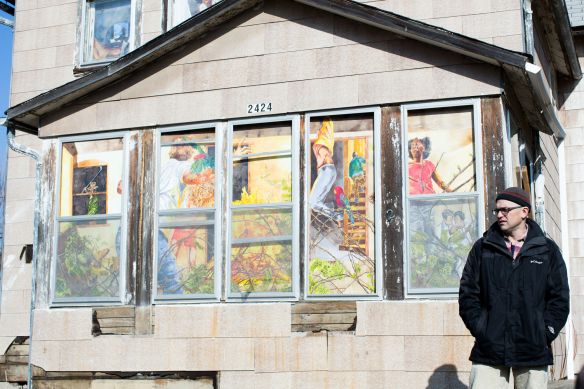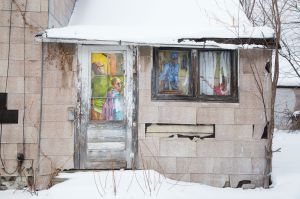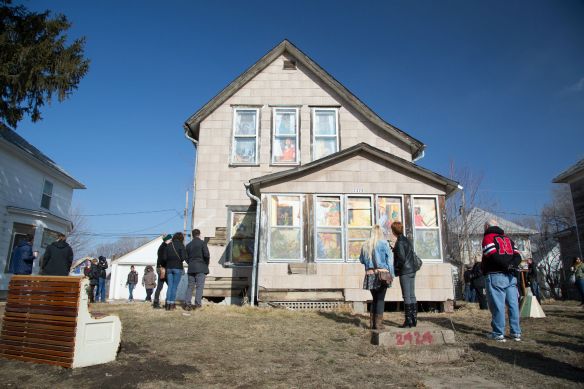Telling Stories Through Art Is My Livelihood
Watie’s Story
When I moved to Omaha from Chicago in 2006, I started getting opportunities to make art in public. One project was an operetta called The Blizzard Voices based on Ted Kooser’s collection of poems. It became a time sequence of charcoal drawings of figures and faces and landscapes that would pair well with the poetry. Then I started getting opportunities to do murals. One offer was for a simple mural of a tree in a middle school, but it wound up being very inspired by my experience with Jim Duignan of the Stockyard Institute, which specializes in arts-based interventions with at-risk youth in compromised neighborhoods. I asked myself how the mural could affect change and open these kids up to possibility.
A big part of life is about stepping back from thinking that you know it all, embracing that you don’t, and also embracing that somebody else might. Community art became conversations, and I started to learn that I was controlling this powerful marketing tool for a community that uses that space.
My medium shifts a lot, sometimes it’s painting, sometimes it’s printmaking. It’s driven by whatever the needs are of the project. The commonality throughout everything is that there’s kind of a confessional narrative that happens over and over again. I’m not trying to tell my story, I’m just the lens through which it gets filtered.
I’m interested in telling the stories of people who don’t think they’re heroic; humble people who don’t think they are worthy of being the subject of real art. Whether rightly or wrongly, people think that if you’re in art you will live forever. I want to give that to someone who has low self-esteem because of questionable choices they’ve made or just because things haven’t gone their way. People’s failings are some of the truest and most fascinating things about someone. Knowing what your great insecurities are or what you’re most shameful of is going to resonate with everyone.
Making the world a little bit better is something I wish to be able to do. Public art often serves a social justice mission. I want to acknowledge the ups and downs of your life. I want to take a crack house that makes you ashamed to live on that street and turn it into a beautiful thing that gets TV crews on your street for a different reason. I’m implicit in making a powerful piece of art; I want to think about what it can do. So when I’m drawing out these detailed, layered pieces, they replace that previous image of a shattered window, grime, or partially-torn screen.
I’m very much a realist in the 19th Century French definition of it; painting real people and real things that say something more about people who are common than people who are grand.
“I’m very much a realist in the 19th Century French definition of it; painting real people and real things that say something more about people who are common than people who are grand.”
About Watie
I was born in 1971 of itinerant cultural anthropologists in Palo Alto, California. Eventually settling in rural Southern Illinois, I worked at the family business, Ancient Lifeways Institute, until attending Carleton College (BA, 1993). Degrees followed at the School of the Art Institute of Chicago (BFA, 1999) and American University (MFA, 2003).
I currently work as a painter and printmaker based in Omaha, Nebraska. Before moving to Omaha in 2006, I was integrally involved for the Chicago Printmakers Collaborative, as well as an adjunct faculty member of DePaul University in Chicago, Illinois.
My work has been exhibited nationally and internationally, including the Schopf Gallery in Chicago Illinoisk, 5+5 IN Brooklyn, New York and the DokHouse Gallery in Amsterdam. My work has also been featured in several publications, including New American Paintings, Almagre, OYEZ Review, Omaha Magazine, and the Omaha World Herald. I am a 2002 recipient of the Stanely G. Wolpoff Award from American University, and have attended several residencies including the Kanaal 10 in Amsterdam, and the International School of Drawing, Painting and Sculpture in Montecastello di Vibio, Italy.
I channel an insatiable curiosity about people’s motives and experiences to connect my prolific and various bodies of work to communities. My specific interest in public art makes abandoned spaces my favorite canvases. No matter the medium, context or scale, I interweave my work with conversation and contradictory points of view as a way to open windows into discourse.
My ability to rationalize a spectrum of views within a visual balance infuses unexpected meaning into my work and reveals there is something very right about disagreement, and something more authentic than truth.



